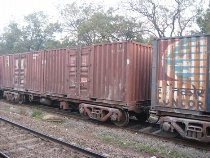 | « Back to article | Print this article |
The light at the end of the much-hyped Dedicated Freight Corridor tunnel will take a long time to be lit.
 Indian Railways' ambitious project of developing Dedicated Freight Corridors, conceived to change the face of its freight traffic business, is set to suffer inordinate delays due to troubles in land acquisition and various other issues.
Indian Railways' ambitious project of developing Dedicated Freight Corridors, conceived to change the face of its freight traffic business, is set to suffer inordinate delays due to troubles in land acquisition and various other issues.
The total land required for developing the eastern and western arms of the freight corridors has been estimated to be 11,180 hectares. Of this, the Dedicated Freight Corridor Corporation of India Limited has issued a notification under Section 20A of the Indian Railways (Amendment) Act, 2008, for nearly 5,000 hectares spanning across eight states. The final notice under Section 20E, which gives the railways special powers to take possession of land for projects of national importance, has been issued for 6,000 hectares.
However, Railway Minister Mamata Banerjee's resolution to refrain from forcibly acquiring land for the project has led to objections surfacing from land owners in Maharashtra, Haryana, Gujarat and Uttar Pradesh. This has forced the corporation to go back to the drawing board to re-examine the alignment of the corridors.
Alignment of the corridors is already being reconsidered at Chandoli and Panvel in Maharashtra, on the Gurgaon-Palampur route, near Mughalsarai in Uttar Pradesh and at stretches in Gujarat.
A former member of the Railway Board said, "Though land acquisition procedures should not be oppressive, realigning the route of the dedicated corridors will result in major delays and endanger the commissioning of a project which is integral to the growth of the railways. The measure will result in cost escalation due to time over-runs."
Further, the minister's assurance may encourage land owners to hold up sections of the project for demanding additional compensation. He added detours from the existing alignment through far-flung areas may give rise to political pressure in the future to run passenger trains on the dedicated freight tracks.
This would defeat the very purpose of the dedicated freight corridor, which is one of India's largest infrastructure project.
Indian Railways currently runs mixed traffic (passenger and freight) on all its existing network of 64,015 route km. Since passenger trains get priority over goods trains, the average speed of freight trains is limited to 25 kmph.
The dedicated freight corridors have been conceptualised to ensure timely delivery of goods by running trains at 75-100 kmph. Operation of passenger trains on the dedicated routes in future would slow down freight traffic to the current levels.
A senior official familiar with the developments said, "Land acquisition problems dogging the corporation is raising considerable concern. What is more important is the corporation has not yet finalised a list of contracts which can be put up under the